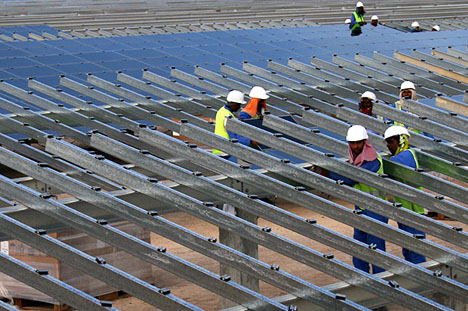 Business & Finance Club - Abu Dhabi : Abu Dhabi Future Energy Company (Masdar) said it has successfully activated the first proprietary double-effect solar thermal cooling system in the Gulf region to test the viability of using the sun’s heat to cool buildings in its key project.
Masdar is the emirate’s multi-faceted initiative advancing the development, commercialisation and deployment of renewable and alternative energy technologies and solutions.
The system, one of only a handful in the world, was activated at Masdar City, the emerging low-carbon cleantech cluster being constructed on the outskirts of the UAE capital Abu Dhabi, said a statement from Masdar.
Designed and engineered by Masdar, the pilot plant is the only one in the world to combine two different concentrating solar thermal collector technologies in a single system, said a top official.
“This project reflects the ongoing innovation taking place at Masdar City as we push the boundaries of sustainable cooling to deliver new solutions that not only compete with conventional systems in terms of quality but also excel in terms of what we can achieve via optimised and cost-effective implementation of state-of-the-art solar technologies,” according to Afshin Afshari, head of Energy Management at Masdar City.
'If successful, the technology could become a major source of cooling across the 6 sq km city,' he added.
According to him, solar cooling is ideal for medium-scale cooling loads, such as those of supermarkets and shopping malls and can also be implemented in a central cooling plant configuration.
It is especially well suited to address peak cooling demand as the solar thermal energy supply closely matches high daytime cooling demand, he added.
Green air conditioning systems generally consist of conventional compression chillers powered by electricity from photovoltaic panels or concentrated solar power plants, said the company statement.
While such conventional chillers and air conditioners use electricity to run a compressor, a double-effect absorption chiller such as the one being tested at Masdar City uses heat to activate a chemical process that provides chilled water for cooling, it added.
The collectors include a Sopogy parabolic trough collector with uniaxial tracking and a total mirror aperture area of 334 sq m. It heats thermal oil, whose heat is transferred to the system’s pressurised water circuit through a heat exchanger.
A Mirroxx linear Fresnel collector with uniaxial tracking and a total mirror aperture area of 132m2 heats the pressurised water directly.
Schneider Electric provided the control system components for the pilot plant and EM Hidromontaza installed the integrated system. The Fraunhofer Institute of Solar Energy will analyse the monitored data and assess system performance.
'The two solar thermal collector systems have been in successful test operation already for more than three months,' explained Simon Bräuniger, project manager for Masdar’s pilot plants.
“The collector’s thermal energy has been driving the Broad 50-refrigeration-ton double-effect absorption chiller that is cooling our office building since mid-September, marking the start of full operation for the pilot project,” he added.
The system provides sustainable cooling to 1700m2 of office space using advanced air-conditioning and delivery equipment from Swegon, such as active chilled beams and an air handling unit that achieves 75 per cent energy recovery.
The objective is to demonstrate that high-temperature solar thermal cooling is more cost effective and requires a smaller collector footprint compared to a conventional electric chiller plant powered by solar-generated electricity.
The solar cooling pilot installation produces cooling equivalent to approximately 80 conventional split-type air conditioning systems, leading to annual emissions reductions of approximately 70,000 kg of CO2, the company said.
The pilot plant will be operated for approximately two years to test the technology’s suitability in Abu Dhabi’s climate and weather conditions, and assess the scope of cleaning and maintenance requirements, it added. |